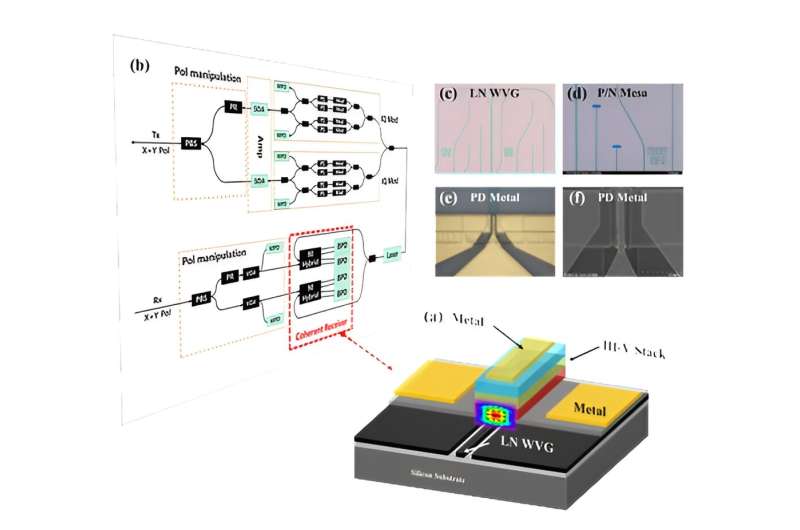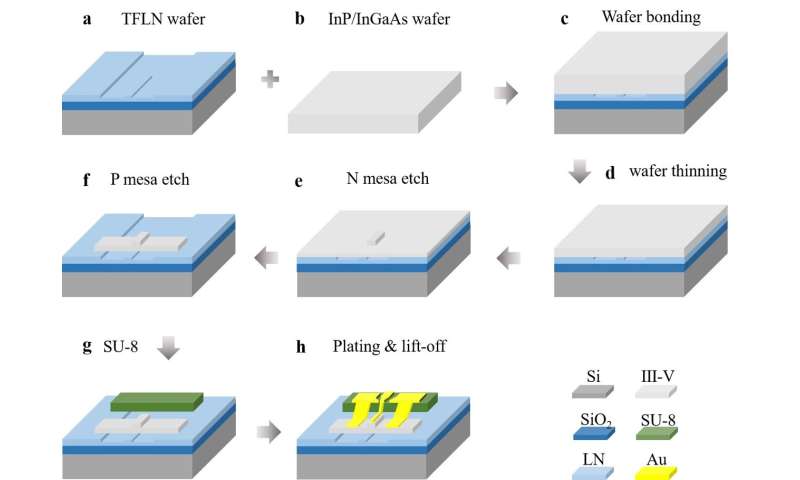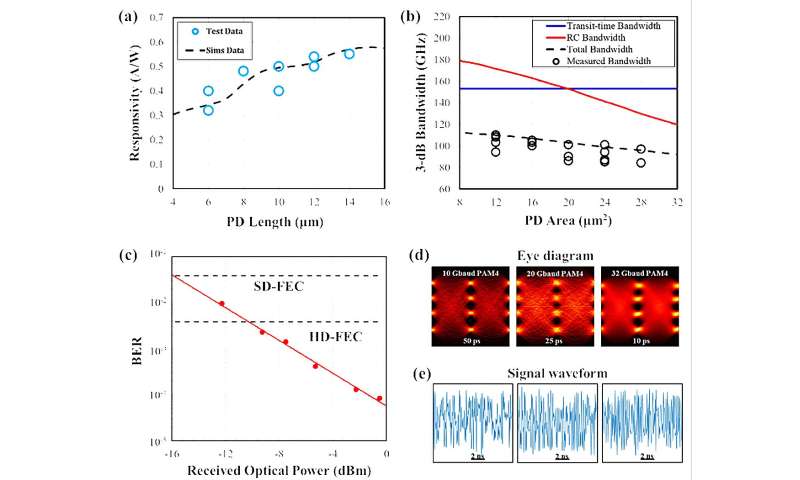This article has been reviewed according to Science X's editorial process and policies. Editors have highlighted the following attributes while ensuring the content's credibility:
fact-checked
trusted source
proofread
Ultra-wideband heterogeneous integrated photodiodes on thin-film lithium niobate platform

Owing to its strong electro-optic coefficient and wide transparency window, lithium niobate (LN) has become an attractive photonic material. Thin-film lithium niobate (TFLN) technology has enabled tight mode confinement and high nonlinear efficiency.
Various compact integrated photonics devices have been realized on the TFLN platform, such as compact high-performance modulators, polarization management devices, and broadband frequency comb sources. However, the inherent difficulty of lithium niobate in realizing light sources and photodetector poses a challenge for the TFLN integrated photonics platform. As an essential optoelectronic component, an on-chip integrated high-performance photodetector is vital for TFLN photonic integrated chips.
In a new paper published in Light: Advanced Manufacturing, a research team, led by Professor Xiaojun Xie and Lianshan Yan from Key Laboratory of Photonic-Electric Integration and Communication-Sensing Convergence, School of Information Science and Technology, Southwest Jiaotong University, China, has reported a high-speed and high-responsivity modified uni-traveling carrier photodiodes heterogeneously integrated on the TFLN platform. The device exhibits a 3-dB bandwidth of 110 GHz and a responsivity of 0.4 A/W at a wavelength of 1,550-nm wavelength.
The fabrication process was initialized by the dry etching of LN waveguides and passive devices. A hybrid etching approach was followed to form device mesa. After metal plating and lift-off, the chips were diced and polished. Epitaxial layer structure, LN waveguide geometry, and CPW pad geometry were optimized to achieve both large bandwidth and high responsivity.
-

(a) TFLN wafer with pre-defined waveguide and passive components, (b) bare InP/InGaAs wafer, (c) InP/InGaAs wafer and TFLN wafer bonding, (d) InP/InGaAs wafer substrate removal, (e) N mesa dry etch, (f) P mesa dry etch, (g) SU-8 base for CPW pad, and (h) metal electroplating and lift-off. Credit: Chao Wei, Youren Yu, Ziyun Wang, Lin Jiang, Zhongming Zeng, Jia Ye, Xihua Zou, Wei Pan, Xiaojun Xie, and Lianshan Yan -

(a) measured (blue circle) and simulated (black dash line) responsivities of the devices with different lengths. (b) Transit-time-limited bandwidth (blue solid line), RC-limited bandwidth (red solid line), total bandwidth (black dash line), and measured bandwidth of the devices with various active areas (black circle). (c) Measured bit error rates (BERs) versus the received optical power for 32 Gbaud PAM4 signal. (d) Eye diagrams and measured waveforms of the PAM4 signal with 10, 20, and 32 Gbaud. Credit: Chao Wei, Youren Yu, Ziyun Wang, Lin Jiang, Zhongming Zeng, Jia Ye, Xihua Zou, Wei Pan, Xiaojun Xie, and Lianshan Yan
To further assess the performance of the devices, the team applied these devices to a data transmission system and successfully detected PAM4 signals at 32 Gbaud with high quality. It was demonstrated that the heterogeneously integrated photodiodes on TFLN platform have the potential to be applied in the next-generation high-speed transmission systems.
This work paves the way to achieving massive-scale, multi-function, and high-performance TFLN photonic integrated circuits. Moreover, it holds a promise for ultra-high-speed optical communications, high-performance integrated microwave photonics, and multi-function integrated quantum photonics.
More information: Chao Wei et al, Ultra-wideband Waveguide-coupled Photodiodes Heterogeneously Integrated on a Thin-film Lithium Niobate Platform, Light: Advanced Manufacturing (2023). DOI: 10.37188/lam.2023.030
Provided by Chinese Academy of Sciences




















